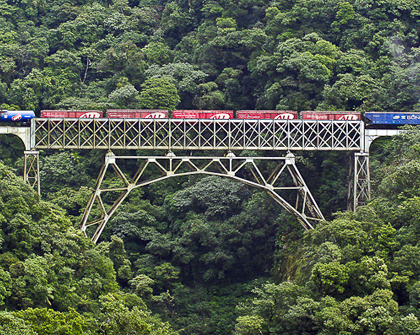The COSIPLAN/UNASUR Network of Freight Logistics Experts (link in Spanish) was created after the countries of South America expressed the need for an online workspace for government officials from different areas that specialize in this issue. The aim is to provide COSIPLAN with guidance on the process of drafting regional policies, projects, and initiatives by identifying research, development, and knowledge transfer requirements for the sector.
As part of the group’s activities, two webinars were held in July 2017. The first, which took place on July 6, was a presentation on the Bioceanic Rail Integration Corridor project from the Bolivia’s Ministry of Public Works, Services, and Housing (link in Spanish). The second was held on July 25 and covered the second National Logistics Survey carried out by Colombia’s National Planning Department (DNP) (link in Spanish).
Colombia’s Second National Logistics Survey
In 2008, Colombia decided to create a national logistics policy and implement a national poll on how logistics processes were performing in the country. The first National Logistics Survey was carried out in 2015 to update the 2008 date and provide the information needed to draft future public policies and comply with the guidelines set out in the 2014–2018 National Development Plan: “Everyone for a New Country” (link in Spanish).
In 2008, the average cost of Colombian firms’ logistics processes was 18%. One of the main findings of the 2015 survey was that this accounted for 14.97% of sales. This cost is greater than in several other countries in the Americas and in Europe: in the United States logistics represents 8.7% of sales, on average; in Europe, 11.9%; and in Latin America, 14.7%.
This exercise was the first time that the Region-Specific Logistics Competitiveness Index was used to evaluate how far different regions of the country facilitated logistics operations on a scale of 1 to 10. The result was a national average of 5.45.
Results of the 2015 National Logistics Survey by Region
Results of the 2015 National Logistics Survey for Performance and Logistics Needs
In 2016, the DNP led the Logistics and Foreign Trade Mission (link in Spanish) in analyzing obstacles that make logistics more costly, in order to draw up a short- and medium-term action plan to reduce current logistics costs from 14.9% to less than 12% by 2030.
To follow up on this, Colombia decided to carry out a second National Logistics Survey in 2018. To gather feedback on the cost of similar exercises in other countries and the methodology used for calculating logistics costs, the DNP suggested a holding a webinar with the Network of Experts. The presentation was given by Katherine Sandoval, the DNP’s Logistics Coordinator.
Those who took part in the activity discussed several factors that are key to Colombia improving its next survey, an experience which will help other countries in the region such as Peru or Paraguay, which have been working toward partial surveys, or Chile, which is planning a national sampling exercise.
Participants agreed that it is essential to establish which areas need to be worked on to facilitate foreign trade, taking the information provided by the World Bank’s Logistics Performance Index (LPI) as a starting point. Germany ranks top of this index, followed by Singapore and the United States. Chile, Mexico, Argentina, Brazil, and Peru rank higher than Colombia in terms of logistics performance. According to the index, Colombia appears to be lagging behind in terms of customs facilities and infrastructure.
The next index aims to compile information from the private sector to measure logistics performance, which is one of the main inputs needed for the government to build public policies to respond to the sector’s needs.
The data it is seeking will focus on four main components: cost and time; quality; productivity; and use of information and communication technologies (ICTs). The survey will also include other areas that may function as variables, such as the level of outsourcing and logistics; logistics for foreign trade (legal framework, external market, and port services logistics); regional analysis of logistics performance and competitiveness in the country’s different departments; and the outlook for logistics.
The activity encouraged dialogue around different methodological matters of interest, and the main conclusions reached were:
- The number of questions on the next survey will be reduced to a maximum of 150 so as to obtain representative results.
- A regular timeframe for the survey needs to be defined, which will ensure that the data is kept up-to-date.
- Colombia was praised for its decision to measure logistics costs as a percentage of sales rather than GDP. This is the indicator used for users of logistics services, but not for suppliers.
- One issue that was discussed was how to account for the effect of inflation on logistics costs, a factor that Colombia solves by measuring cost as a percentage of sales.
- The importance of generating indicators that can be compared over time was also mentioned. To this end, it was decided that stable markers or indicators should be used whenever the survey is carried out, in combination with other indicators that may not necessarily be gauged for every survey but that leave room for inquiry into other areas.
- It was suggested that some indicators for logistics maturity be included—that is, how far they play a part in the country’s and the region’s more sensitive supply chains, with the eventual aim of implementing similar surveys in other countries so as to be able to compare results.
- Those who took part in the webinar exchanged opinions on whether it would be useful in the short term to use a compound indicator, that is, one that combines several indicators. Colombia said it had attempted to use this alternative, but it had been forced to put it aside in the short term due to consistency problems.
- They also discussed the fact that some indicators allow the causes of certain distortions to be identified, such as how time spent complying with foreign trade processes impacts logistics costs.
The session ended with a cooperation agreement that will allow Chile, which is about to implement its first logistics survey, to learn from the Colombian experience.
Bolivia’s Bioceanic Rail Integration Corridor
The Central Bioceanic Rail Corridor (CBFC) is a rail project that has been prioritized by the government of Bolivia and which aims to join the Atlantic port of Santos in Brazil with the Pacific port of Ilo in Peru. This rail connection is the optimum alternative for shipping large volumes and weights of Bolivian mining, farming, and forestry commodities to international markets.
This project is part of the COSIPLAN Integration Priority Project Agenda (API)and its scope was described in an article in INTAL Connection in June 2017. It was also on the agenda at the Meeting of the Working Group on Rail Integration (link in Spanish) held on July 13, 2017, in Montevideo, Uruguay.
Central Bioceanic Rail Corridor Route Map
As part of the Network of Logistics Experts, Alberto Gutiérrez from Bolivia’s Ministry of Public Works, Services, and Housing presented the project with the aim of exchanging opinions and getting feedback from the other participants on factors that could potentially improve Bolivia’s rail freight logistics.
Bolivia received financing from the IDB to carry out technical, economic, financial, and socio-environmental studies to determine the viability of this bioceanic rail link.
The country has recently signed a Memorandum of Understanding with Peru and Brazil, which was then signed by Paraguay and Uruguay and which Argentina will soon also be party to.
The multiple factors that were analyzed during the webinar include the type of freight to be transported (soy, bulk liquids, zinc, containers, iron, and bulk dry goods); the origin and destination markets for these goods (intra- and extraregional imports and exports and transit); the potential effects of diverting container freight to the port of Ilo; and new opportunities for developing logistics centers in the immediate environs of freight terminals in major cities.
These future logistics centers could provide services such as customs dispatch, consolidation, and deconsolidation and could eventually be combined with urban delivery platforms. A dry port is planned in Patacamaya or Viacha, while there is also potential for logistics centers in Roboré (which connects with the branch from Paraguay) and the dry port at Oruro, which is being re-evaluated as an alternative dry port for the rail system.
Bolivia is also considering the possibility of facilitating authorized economic operator (AEO) certification to railway users, taking advantage of the fact that it is a natural extension of the primary customs zone.
At present, the Bolivian rail system is made up of the Andean Network (in the west of the country), which is in the Bolivian highlands and has 2,276 kilometers of track, and the Eastern Network, which is made up of 1,246 kilometers of track in the lowlands. The two networks have never been connected to one another due to a lack of infrastructure in the center of the country. The eastern section of the network connects with Brazil and Argentina and the western section with Chile, Peru, and Argentina.
Freight from Brazil to Asia must currently be shipped via the Panama Canal, taking 67 days to travel more than 25,000 kilometers. Building this large-scale rail infrastructure project would cut that time by half.
The network’s current axle load capacity is a maximum of 15 metric tons per axle, which falls short of the volume that it is hoped will be transported in the future. An assessment of the current structure of the Bolivian rail network and an estimate of the freight that it might be expected to carry over the next 40 years suggests that this infrastructure could be taken advantage of by increasing and homogenizing the load capacity along the entire corridor.
At the regional level, the Bioceanic Rail Integration Corridor is a project that will play an enormous part in connecting central South America by enabling a direct connection between the continent’s east and west coasts, which will lead to reductions in export costs and times within the region and overseas.
Links related to the Central Bioceanic Rail Corridor: [1] [2]







